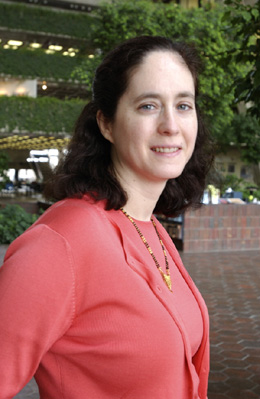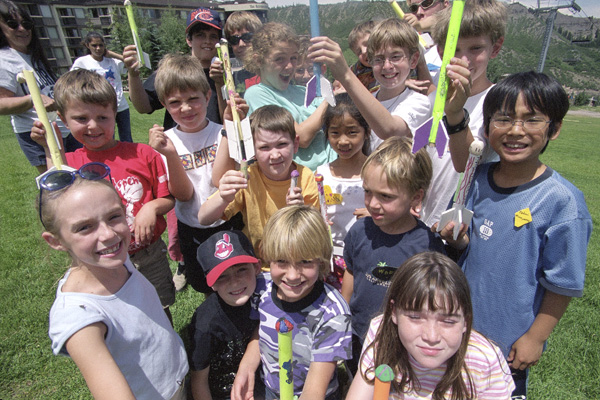 |
|
Far-Reaching Results
by Sena Desai
Elizabeth Simmons’ office shelves at Boston University are crammed with little gadgets —toys that a child would love to have,and craftwork that her two sons have made at school. But to Simmons they represent complex equations come to life.She often uses these gadgets to explain an elusive physical theory or concept.In fact, she admits that she borrows her sons ’toys to explain physics to high school girls who participate in her Pathways outreach program at Boston University. “The most interesting aspect of my work is connecting an abstract creation of the mind to what really exists,”Simmons says.“In particle physics there is symmetry to models,like a cut jewel,that makes them very interesting.” A theorist at B.U.and a visiting researcher at Fermilab for 15 years,Simmons is committed to bringing more women into the field and making life easier for fellow women physicists. Though their numbers are creeping up in the United States,women physicists are still greatly outnumbered by men.Simmons says that only 20 percent of bachelor ’s degrees and about 13 percent of Ph.D.s in physics are awarded to women.Women represent just ten percent of the nationwide physics faculty;a survey in the March 2001 report of the American Institute of Physics also suggests they are more likely than men to be hired on a temporary basis.National trends are reflected at Fermilab,where 21 of the 228 physicists (nine percent)are women. In the last 25 years,the number of women physicists in the United States has doubled,but Simmons describes this progress as “pathetically slow ” compared to the life sciences.She says there is a subtle discrimination that women physicists still face.“I am not saying that they mean to,but men often interrupt or don ’t listen to what a woman has to say,”Simmons says.She adds that while some women learn to deal with this subtle discrimination, others may become discouraged and drop out of the field,which may help explain why there are proportionately fewer women at higher levels of physics than in the field as a whole. Simmons appears to be among the exceptions that prove the rule.Besides teaching and outreach, her activities include membership in the Particle Physics Project Prioritization Panel (P5),which met at Fermilab recently to evaluate future physics projects.P5 advises the High Energy Physics Advisory Panel (HEPAP)on which physics projects to fund,and HEPAP in turn advises the Department of Energy and the National Science Foundation. Simmons believes young women may be intimidated by the mathematical requirements of physics.They may also see direct societal benefits from the life sciences,but not from basic research. Simmons has hoped to make physics attractive for high-school students,especially girls,encouraging them to study physics at higher levels.When she joined the physics faculty at B.U.in 1993 she also founded Pathways,her own science outreach program. Through this two-day program Simmons, each year,brings in about 400 girls and their teachers from 40 Boston-area schools to B.U.The students meet and interact with about 100 different researchers and engineers,mostly women.“They find out about different careers and different types of science and engineering,”says Simmons.The girls listen to talks on recent research in physics,try out hands-on experiments, and take lab tours.Though Simmons is involved in other outreach efforts,she says that Pathways is “closest to her heart.” Outreach can work both ways.Simmons credits encouragement from several male physicists in building her own career.Her physicist husband,Sekhar Chivukula,has “always been a pillar of strength and support.”Howard Georgi, her Ph.D.advisor at Harvard University, continues to encourage Simmons 13 years after she graduated.At Fermilab,she has a staunch ally in theorist Chris Quigg. Quigg says it is important for young girls to see successful women like Simmons in physics.“They can look at her and say,‘Oh,if she can do it,why can ’t I?’”says Quigg.“It is wonderfully empowering to walk through places where people have passed through and gone on to do wonderful things,” he says.“To see someone like Liz as an example is energizing and liberating.” Simmons has an overarching goal of helping women in physics move forward into positions of prominence.She has been able to effect specific changes as a board member of the Aspen Center for Physics in Aspen,Colorado. A non-profit organization run by physicists,the center is known for its annual three-month summer program where physicists from around the world meet to discuss,puzzle,and exchange their ideas unhampered by everyday demands.Simmons says physicists who attend feel “renewed and revitalized.”The program is highly competitive, and physicists consider it a privilege if they are asked to attend. Simmons noted that few women were participating in the conferences;when they were participating, they seemed to occupy less prominent levels than they deserved.In the summer of 1994,Simmons with two other physicists,Catherine Kallin (McMaster University)and Katherine Freese (University of Michigan),ran a weeklong workshop called the “Focal Week on Women in Physics.” The workshop came up with a list of suggestions to increase women ’s participation at the Aspen summer program —and the percentage of women attending the program has now doubled. Simmons made prominent contributions as the chair of the Aspen 2001 Snowmass conference ’s outreach committee.Liz Quigg of Fermilab ’s Education office remembers that Simmons had set up a huge tent for her outreach activities on a hot Fourth of July.While it was the day off for the conference,Simmons spent all day in the heat, helping children with activities related to physics that she had set up —puzzles,small experiments, and demonstrations,many borrowing her sons ’ toys. Chris Quigg,the chair of the Snowmass conference ’s organizing committee knew exactly why he asked Simmons to chair the outreach committee.“I wanted a very serious,energetic, and rigorous program of outreach,”he says. And,he says,Simmons brought that energy and enthusiasm to the outreach “beyond my wildest dreams.She is really very good at bringing in other people and giving them their moment in the sun.” Simmons has special communication tutors. A former middle-school teacher helps polish her approach.“She helps us know how to speak with students and how to present things at a level that is not too technical,”says Simmons.And,of course,the fact that Simmons has two sons,four and 11,helps her hone her communication skills. “You learn to choose your words carefully when you are talking to a four-year-old,”she laughs. “Or he will keep asking you the same question again and again until he is satisfied.” There are special moments that make all the effort worthwhile,like the times when Simmons does a little demonstration and a student says:“Wait —this is something we have done in our physics class!” “It is really great to see them making the connection between an equation they saw in class and an object that you are handing them to look at,” Simmons says.Even more gratifying are the moments when a student who has attended one of her programs writes to say that he or she has decided to study physics in college. Chris Quigg says Simmons is one of the important reasons for the growing presence of women in physics.The field of particle physics,especially, has always prided itself on international collaboration,and Simmons,fittingly,practices physics outreach without borders. “Every now and then,”Quigg says,“I am surprised, but not astonished,to get a request for a letter of recommendation because Elizabeth has found some other program to do with people in South America or Japan.”
|

